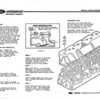Here’s the installation instruction from Ford. It might be a bit hard to read but I cant upload a high resolution copy. The 65-70ft-lbs mentioned above would be consistent with the torque for installing the studs in the head (not acorns). 70-75 in-lbs (about 6 ft-lbs) is the torque called out for the acorn nuts. The 65 in-lb call out is actually for the ¼-20 valve cover mounts to the head. The hardware stack beneath the acorn nut was a soft copper washer and an aluminum spherical washer (flat on one side spherical on the other). The Dowty washer would work fine for replacing the copper washer provided you can find one with a 7/16 ID and an OD small enough to clear the well, but the spherical washer is still a potential source of leakage, thus the instructions call for applying a small amount of RTV to the spherical side. Be advised, the original acorn nuts also had a nylon insert that made them a locking fastener of sorts.
The most common source of leakage is from the use of thick valve cover gaskets that can take a compression set. When this happens, the torque applied to the acorn nuts is lost and they leak. The instructions refer to the valve cover gasket as a “special gasket”. It’s .060” thick and made from ordinary paper/fiberous gasket material, but they are relatively resistant to taking a compression set compare to typical cork or neoprene gaskets.
In practice, the acorn nuts apply more force to the valve cover gasket than the ¼-20 mounting screws do.
Jan, yours appear to have thicker aftermarket gaskets. If they were relatively sealed before, merely re-torquing the acorn nuts may do the trick if they have merely taken a little set. If your ¼-20 screws are also loose, that would also point to the gaskets having relaxed a bit.
I note earlier remarks in the thread about these being made from poor quality materials incapable of being polished. Though I cannot speak for all of production, I’ve had about a dozen sets of these through my hands and have not found that to be the case. I have seen several polished sets that actually looked pretty good and have also welded and seen many welded mods to them, usually adapting breathers to them. The ones I’ve welded received weld quite nicely. The studs are actually quite nice in quality but hard to come by.
I have never actually seen a cracked set from over tightening as Doug mentions but can well imagine 60-70 ft-lbs on each acorn nut would likely do that. I’ve actually found the valve cover itself to be pretty stout.
Lastly, as for them being a PITA to use, I didn’t really find them any more so than other stud girdles, although for real racing gear, I’d rather apply the girdle independent of the valve cover so lash can be checked after the girdle is tightened.
You must admit though, the fangle factor is quite high.
Best,
Kelly
PANTERA INTERNATIONAL
A DE TOMASO CAR CLUB
Presents the De Tomaso Forums
The On-Line Meeting Place for De Tomaso Owners and Enthusiasts From Around the World
Clicking on the banner will take you to the sponsor's website.


